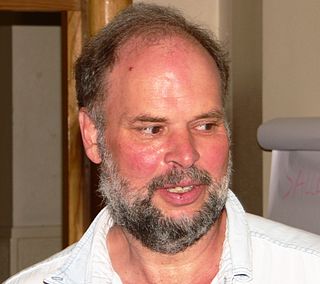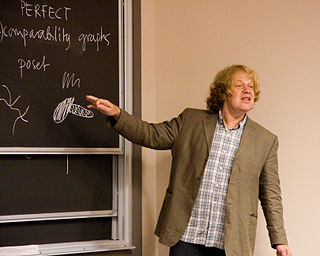Combinatorics is an area of mathematics primarily concerned with counting, both as a means and an end in obtaining results, and certain properties of finite structures. It is closely related to many other areas of mathematics and has many applications ranging from logic to statistical physics and from evolutionary biology to computer science.

Jacques Tits was a Belgian-born French mathematician who worked on group theory and incidence geometry. He introduced Tits buildings, the Tits alternative, the Tits group, and the Tits metric.

Ronald Lewis Graham was an American mathematician credited by the American Mathematical Society as "one of the principal architects of the rapid development worldwide of discrete mathematics in recent years". He was president of both the American Mathematical Society and the Mathematical Association of America, and his honors included the Leroy P. Steele Prize for lifetime achievement and election to the National Academy of Sciences.

Béla Bollobás FRS is a Hungarian-born British mathematician who has worked in various areas of mathematics, including functional analysis, combinatorics, graph theory, and percolation. He was strongly influenced by Paul Erdős since the age of 14.

Sir Vaughan Frederick Randal Jones was a New Zealand mathematician known for his work on von Neumann algebras and knot polynomials. He was awarded a Fields Medal in 1990.

Peter Clive Sarnak is a South African-born mathematician with dual South-African and American nationalities. Sarnak has been a member of the permanent faculty of the School of Mathematics at the Institute for Advanced Study since 2007. He is also Eugene Higgins Professor of Mathematics at Princeton University since 2002, succeeding Andrew Wiles, and is an editor of the Annals of Mathematics. He is known for his work in analytic number theory. He also sits on the Board of Adjudicators and the selection committee for the Mathematics award, given under the auspices of the Shaw Prize.

In graph theory, the Möbius ladderMn, for even numbers n, is formed from an n-cycle by adding edges connecting opposite pairs of vertices in the cycle. It is a cubic circulant graph, so-named because (with the exception of M6, Mn has exactly n/2 four-cycles which link together by their shared edges to form a topological Möbius strip. Möbius ladders were named and first studied by Guy and Harary .
In mathematics, the Bruhat order is a partial order on the elements of a Coxeter group, that corresponds to the inclusion order on Schubert varieties.

Václav (Vašek) Chvátal is a Professor Emeritus in the Department of Computer Science and Software Engineering at Concordia University in Montreal, Quebec, Canada and a Visiting Professor at Charles University in Prague. He has published extensively on topics in graph theory, combinatorics, and combinatorial optimization.

János Pach is a mathematician and computer scientist working in the fields of combinatorics and discrete and computational geometry.
András Hajnal was a professor of mathematics at Rutgers University and a member of the Hungarian Academy of Sciences known for his work in set theory and combinatorics.

Uppaluri Siva Ramachandra Murty, or U. S. R. Murty, is a Professor Emeritus of the Department of Combinatorics and Optimization, University of Waterloo.
Daniela Kühn is a German mathematician and the Mason Professor in Mathematics at the University of Birmingham in Birmingham, England. She is known for her research in combinatorics, and particularly in extremal combinatorics and graph theory.
Dominique de Caen was a mathematician, Doctor of Mathematics, and professor of Mathematics, who specialized in graph theory, probability, and information theory. He is renowned for his research on Turán's extremal problem for hypergraphs.
Nicholas Charles Wormald is an Australian mathematician and professor of mathematics at Monash University. He specializes in probabilistic combinatorics, graph theory, graph algorithms, Steiner trees, web graphs, mine optimization, and other areas in combinatorics.
Anthony J. W. Hilton is a British mathematician specializing in combinatorics and graph theory. His current positions are as emeritus professor of Combinatorial Mathematics at the University of Reading and Professorial Research Fellow at Queen Mary College, University of London.
Wojciech Samotij is a Polish mathematician who works in combinatorics, additive number theory, Ramsey theory and graph theory.
Jean Berstel is a French mathematician and theoretical computer scientist known for his contributions to combinatorics on words and formal language theory. He is a currently a professor emeritus at the University of Marne-la-Vallée.

In combinatorial mathematics and extremal graph theory, the Ruzsa–Szemerédi problem or (6,3)-problem asks for the maximum number of edges in a graph in which every edge belongs to a unique triangle. Equivalently it asks for the maximum number of edges in a balanced bipartite graph whose edges can be partitioned into a linear number of induced matchings, or the maximum number of triples one can choose from points so that every six points contain at most two triples. The problem is named after Imre Z. Ruzsa and Endre Szemerédi, who first proved that its answer is smaller than by a slowly-growing factor.
Mirka Miller was a Czech-Australian mathematician and computer scientist interested in graph theory and data security. She was a professor of electrical engineering and computer science at the University of Newcastle.










